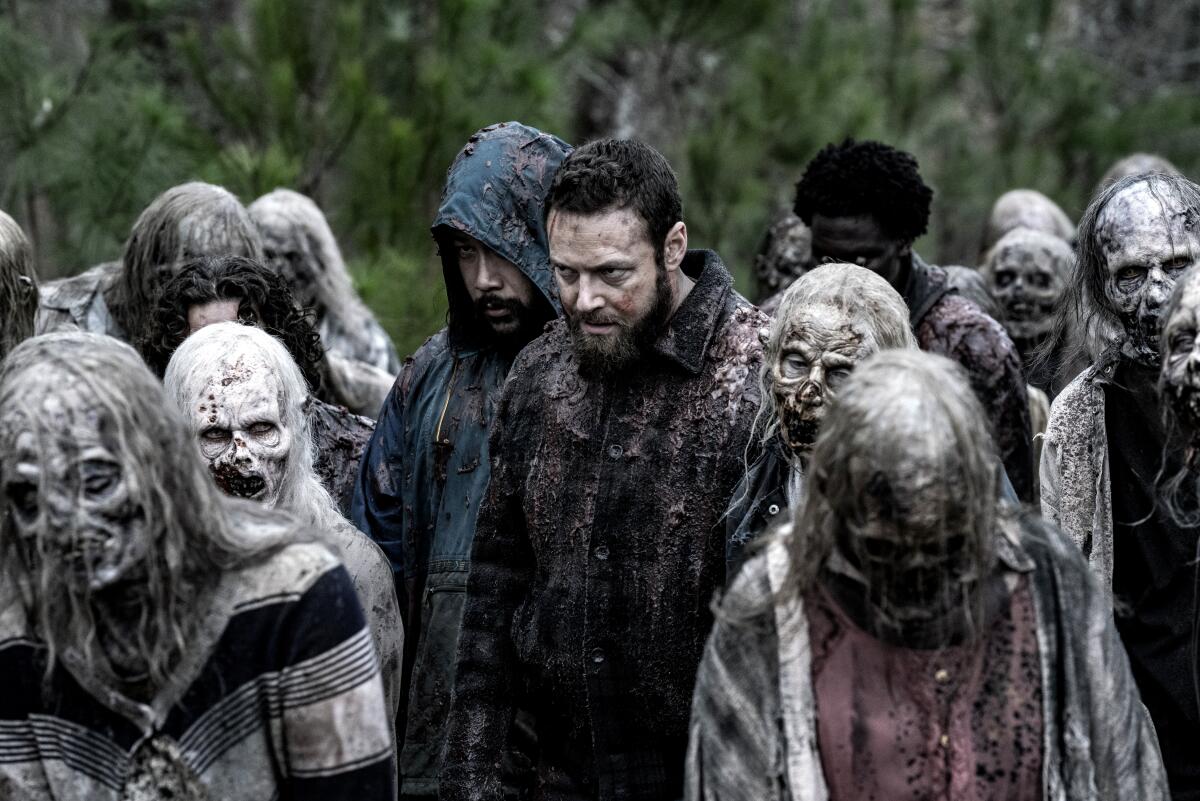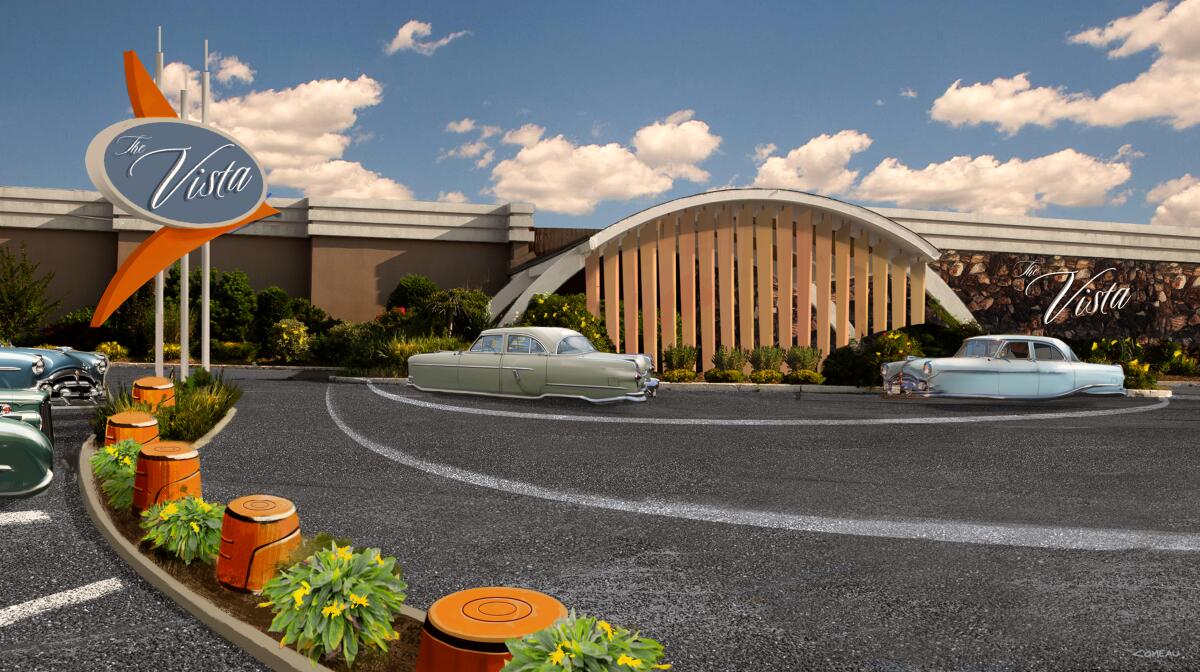Pick your own doomscape: The future looks bleak on TV

- Share via
TV viewers who enjoy mass disaster scenarios have had plenty of opportunities recently to picture the end of the world as we know it. Last year, “Station Eleven” followed survivors making their way through a world that nearly froze to death. This summer, “Silo” imagines 10,000 people living underground to avoid contact with a lethally toxic environment while “Black Mirror” reflects a profusion of tech-gone-bad hellscapes. These exemplars of television’s new apocalypse represent a departure from traditional big-screen spectacles that blamed asteroids or alien attacks on planetary collapse. Disaster movies of yore now seem almost quaint, as if external forces would be required to bring planet Earth to its knees.
This Emmy season, four series offer thoughtful variations on the theme of global doom. Here’s a look at shows that fictionalize ways in which brain-infecting viruses, unchecked carbon dioxide and hucksterism could determine whether the world ends with a bang or a whimper.
‘The Last of Us’
HBO
What went wrong: A (fictional) mutation of the (actual) poisonous cordyceps fungus goes viral.
When: On “Breakout Day” in 2003, the fungal virus infects millions of human brains and turns people into killing machines. By 2023 the “infected” have ravaged the land, taken out the power grid and forced survivors into hiding.
Premise: Joel (Pedro Pascal) and the virus-immune 14-year-old Ellie (Bella Ramsey) trek cross-country on a quest to see if Ellie’s blood can help the Fireflies resistance group find a cure for virus.
Pedigree: Video game of the same name was created in 2013 by Neil Druckmann, then adapted for television by Druckmann and “Chernobyl” creator Craig Mazin.
Landscape: Filmed primarily in Alberta amid the pristine Canadian wilderness. Production designer John Paino teamed with CGI artists to render the city of Calgary as a devastated stand-in for the ruins of Boston and Kansas City.
Aesthetic: “There’s a lot of things in ‘The Last of Us’ having to do with nature taking back the earth without mankind getting in the way,” says director of photography Eben Bolter. “If you look at a shopping mall right now, it’s probably going to be pretty ugly but if you go for 20 years [without humanity] and nature creeps back into that mall, you really appreciate the natural beauty.”
Upside: Noting that the show’s young hero was raised in a blighted “quarantine zone,” Bolter says, “Ellie’s seeing sunsets for the first time.”

‘The Walking Dead’
AMC
What went wrong: Zombies
When: Now
Pedigree: Based on the 2003 comic book by Robert Kirkman and artist Tony Moore.
Why: The zombification backstory is never explained. Scott M. Gimple, AMC’s chief content officer of “The Walking Dead” universe, says “It isn’t definitively a virus or fungus or bacteria or a space spore, as Mr. Kirkman joked. It might be any of those things or all those things. The fog of it all is a big part of the show. But it seems to have happened much more quickly than COVID.”
Landscape: Rural Georgia backdrops most of the action pitting survivors against zombie “walkers.” “Georgia has a wonderful amount of crumbling places that we shot some beautiful decay in,” Gimple says. On the urban front, CGI-manipulated images depict downtown Atlanta after it’s been napalm-bombed by government forces in a failed effort to eradicate the undead flesh eaters.
Aesthetic: Mundane monsters. Gimple says, “One image that comes to mind, going more towards the dread [end of the] spectrum was a single [zombie] walker striding through a field, alone. This everyday, atmospheric idea that it’s as normal as birds flying across the sky [confirms] that this is now a world that belongs to the dead.”
Upside: In the series finale, one year after zombie hordes die in a giant fire, survivors thrive in a commune-like settlement complete with a rainbow-painted windmill, optimistic children and a virtuous new governor Ezekiel (Khary Payton) replacing 11 seasons’ worth of corrupt politicians. Rogue hero Daryl (Norman Reedus) rides off into the sunset on an ethanol-powered motorcycle. “Love wins over fear, at least in the long term,” Gimple says. “In the short term, fear and horror definitely get their shots in.”

‘Extrapolations’
Apple TV +
What went wrong: Global warming
When: From 2037 through 2070 as temperatures rise 2.59 degrees caused by increased levels of carbon dioxide.
Premise: Unchecked human consumption and unchecked profit motives undermine efforts to protect an incrementally devolving environment. Producer Dorothy Fortenberry told the L.A. Times’ Boiling Point newsletter, “The guiding principle behind the timeline was, what if we just keep muddling forward as we are?”
Pedigree: Created by Scott Z. Burns, producer of Al Gore’s now prophetic “An Inconvenient Truth” documentary and writer of 2008’s “Contagion” movie, which anticipated with eerie accuracy the COVID-19 pandemic.
Landscape: Flooded coastal regions in 2047 Miami, where worshipers wear galoshes at the local synagogue, and skies are tinged a sickly yellow with pollution in 2057 India, where smugglers go out only at night when the atmosphere is less poisonous.
Aesthetic: Production designer Sam Lisenco says, “As much as we’d like the future to be sleek, clean and bold, in actuality you accrue more junk in your kitchen drawer over time. Those sorts of layers help imply the past and allow the audience to make assumptions about what that would mean for the future. From there, it was natural to punctuate moments with hyper-futurist aesthetics, like cars and devices that would be inherently more of the moment.”
Upside: In the future, humans invent audio avatars that transform whale vocalizations into human voices. Cue Meryl Streep’s voice as the last surviving whale on Earth.
Secret weapon: All-star cast includes Streep, Sienna Miller, Kit Harington, Edward Norton, Diane Lane, Daveed Diggs, David Schwimmer, Tahar Rahim, Yara Shahidi, Matthew Rhys, Gemma Chan and Indira Varma.

‘Hello Tomorrow!’
Apple TV+
What went wrong: The timeless plagues of loneliness and quiet desperation
When: The late 1950s reconfigured as a retro-futuristic parallel universe
Premise: A slick salesman (Billy Crudup) optimistically pitches “Brightside” condos on the moon to the unhappy citizens of suburban Vistaville.
Pedigree: Original idea from showrunners Amit Bhalla (“Bloodline”) and Lucas Jansen (“This Is Not a Robbery” documentary)
Central irony: The very design features associated with the future in 1958 now scream “vintage.”
Landscape: The show was filmed in New York state, including the suburbs of Long Island, where “Vistaville” exteriors were shot.
Aesthetic: In addition to the ravaged landscape of the human soul, production designer Maya Sigel says, “I tried to take off my 2023 glasses and think about what people in the 1950s thought the future would look like. I sorted the world into the past/traditional style and the futuristic/moon style. The Vistaville architectural lines are all straight, the houses are traditional and boxy. For everything that’s futuristic or has to do with the moon, I used curves and circles. For example, Jack sells the Brightside homes with the aid of our miniature model which is a circular residence under a dome. This principle continues with the technology and all of our gadgets, which are streamlined and aerodynamic, drawing inspiration from the most cutting-edge space age design of the time.”
Upside: A moon-bound rocket ship filled with hopeful passengers achieves liftoff.
More to Read
From the Oscars to the Emmys.
Get the Envelope newsletter for exclusive awards season coverage, behind-the-scenes stories from the Envelope podcast and columnist Glenn Whipp’s must-read analysis.
You may occasionally receive promotional content from the Los Angeles Times.









